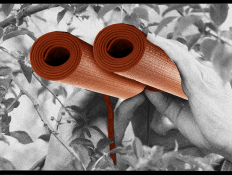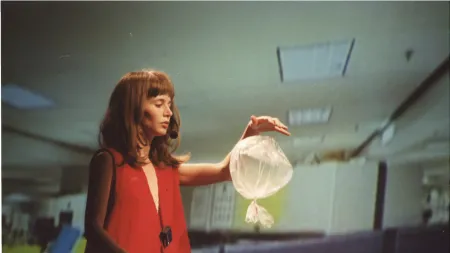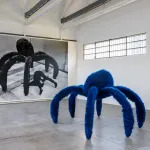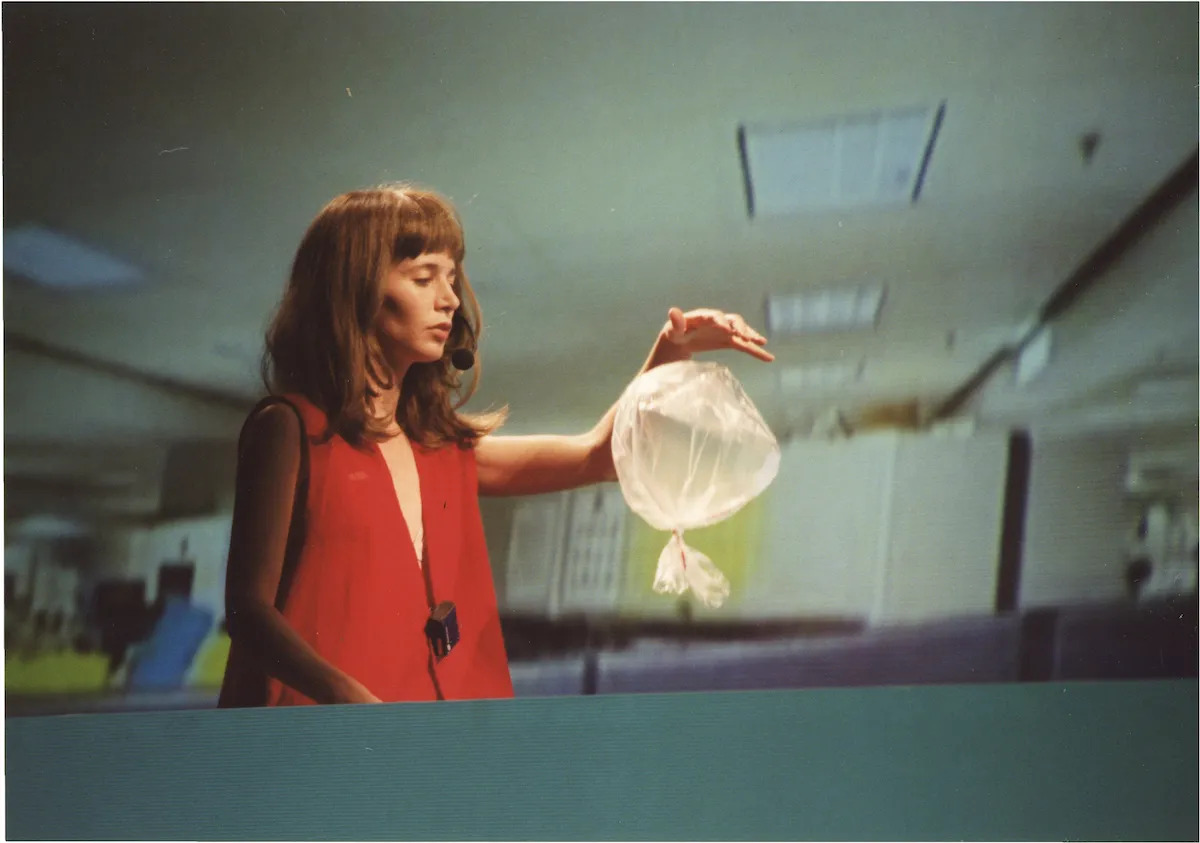
Editor’s Note: This conversation between Cindy Sherman and Miranda July was originally realized for #37 Miranda July: New Society, part of the Quaderni series published by Fondazione Prada. That publication was published to coincide with the exhibition “Miranda July: New Society,” currently on view at Osservatorio Fondazione Prada in Milan until October 28. With permission, ARTnews is republishing that piece in its entirety here.
Cindy Sherman: Tell me about the new videos. What is behind them?
Miranda July: Well, I was writing this book, All Fours (2024), and I would occasionally get up and dance in my office, partly because it got uncomfortable sitting in a chair for four years and partly because there is dance in the book. I would sometimes post the dances on Instagram, which eventually created this dancer persona that I was not totally comfortable with, honestly. Meanwhile, my marriage and family were changing. I created an acronym for the word ‘family’: ‘Falling Apart Meanwhile I Love You.’ And then, at the start of 2023, Apple released an iPhone update that included a cutout tool, where you press on a person in a picture, and the tool cuts an outline out around their body so you can drag or drop them somewhere else.
Sherman: Oh, yes. I saw that.
July: I remember thinking, “Why now? Why have we been given this tool now? Did this come out of the pandemic, people not being able to physically be with each other? And what else can be done with it?” I formed this research group to explore bringing people into a space with me, using this tool. I put out a casting call on Instagram, and hundreds of people sent their pictures.
Sherman: How did you select the participants? Did you have some kind of criteria in your mind, or was it random?
July: Well, I knew this project would somehow have to do with intimacy, so I wanted some people who were comfortable showing a lot of skin and some people who were not, who liked to be covered up. I asked people to send pictures of themselves wearing the least amount of clothes they felt good in, and then from the photo submissions I tried to create a diverse group, in every sense.
I started by giving the participants photo assignments but eventually realized it was more interesting to use video to capture movement. There are similar cutout tools for video editing—of course, the ones for making TikTok content.
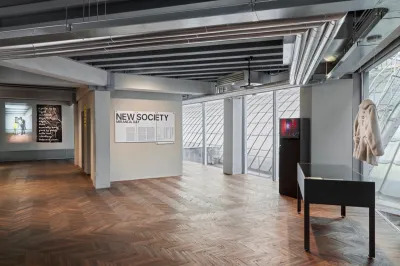
Sherman: I like the funkiness, how bits and pieces are floating in and out of the background.
July: Right. Because we are not using green screens and proper lighting, the cutout tool picks up chunks of the background sometimes, thinking they are part of the body. Or it cuts off body parts inadvertently. I like how this confuses things a bit. One person in the group, Donald (@donaldklee), uses a prosthesis or a wheelchair day-to-day but moves very elegantly without any support. He is the only professional dancer in the group and inspired my thinking a lot.
Sherman: He took a video of himself and then sent it to you? Is that how it worked?
July: I set up a private Instagram account for the research group—there are seven people plus me—and then I posted assignments and they would upload their responses via the link in the bio. At first, the briefs were very detailed and directed, and then someone would get it ‘wrong,’ and I realized that was the best outcome, of course. So I started to leave it more open. I would say, “You show me how you want to be touched, and I will figure out how to fit us together.” Everyone moves differently, has a different shape, has different abilities, so for a long time I just experimented, trying to invent a new way of gathering bodies together. Gradually, after months of staring at these forms, I created a visual language. For instance, there is always a flat surface because of the floor. But if I changed the video orientation that surface can be used to defy gravity, and the ceiling can also be a floor. Or if two people kiss the floor, you have two flat surfaces you can put together. One day I DMed @nitegallery and asked her to kiss the floor so I could try that out. It’s funny, I only know these people through their Instagram names.
Sherman: It sounds really inspiring to be working with strangers, encouraging people to make mistakes, and running with it. I like how they are all-absorbing, becoming these blobs that then have a life of their own.
July: Yes, the sheet blobs.
Sherman: Were those part of the initial idea?
July: No, the sheets came in because I got hungry for some kind of abstraction. The risk with any group like this, especially such a small group, is that each person can become simply representative of their gender, race, and so on. Those things are interesting but I am also interested in intimacy and shapes and longing, and I am thinking about a very personal sort of spirituality. Anyway, I had recently bought this book about sculpture in Europe in the 1400s that had pictures of marble figures with lots of drapery, and I recognized the beauty of the fabric, the folds, both classical and ghostlike. Sometimes I think of them as ectoplasms.
Sherman: They are definitely ghostlike, with the shifting of what is in and out of view, the morphing of the sheets. What will the sound be like when you are done?
July: The ones I sent you are currently without sound. I am working with the sound designer from my feature films, Kent Sparling, who is adding in the foley sound effects, all the footsteps and slaps and kisses, all the ordinary sounds that would be created if we actually were in the same space together.
Sherman: So, you are pulling in skills from your other work.
July: I was thinking about you while working on this project, because making these videos involves a lot of looking at myself and my body. And I am changing, my body is changing. Occasionally, I will catch a shot of myself walking towards the camera and think, “Oh, I look more like my mom than I realized.” I will notice my jaw is oddly lumpy, for example.
Sherman: I know what you mean. In my recent work, the black-and-white images, I had used a new digital camera that can produce extremely high resolution images. I was shooting close to my face, so I saw every little detail. I did not know I had wrinkles on my ears before! Every little imperfection is so blown up. It can be kind of scary.
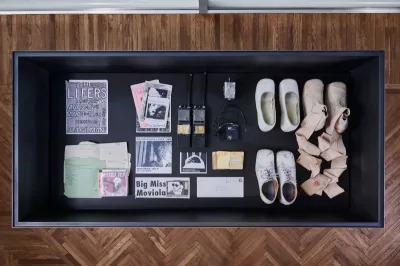
July:Have you ever thought about your work as a document of your aging, even if it was not intended as that, at least not initially? I guess I have been thinking about this lately and wondered if you had thoughts about it, since we both appeared in our own work so much at an early age and now we are . . . Well, we are different ages, but neither of us is young anymore. Do you think about this ever?
Sherman: Yes, even though I am using makeup and disguises, I still see the details of my own aging process in the work. It is hard to remain objective about it.
July: It is like going from having a young, kind of general face that can easily look like a lot of other faces, to having . . . I mean, part of what wrinkles do is make your face more like a fingerprint. It becomes more specific.
Sherman: [Laughs.] That is true!
July: It gets more and more specific as you age, which is a different material to work with. Not that I am working with it the way you are. I am in the nervous middle-age time, wondering about what is to come.
Sherman: Living in Los Angeles, you must be very used to seeing people who are trying to constantly erase those details, which is kind of like erasing your identity. Through aging, as you said, you embed more of yourself into your skin.
July: Right, I guess one is always building themselves in relation to the people around them, and it probably takes some extra recalibration, living here in LA. I wish this was not the case. I would prefer to have some more unique things in my head, you know?
Sherman: I am embarrassed to say this but in spite of all the work I have done playing around with ugliness versus beauty and identity, I still do not want to feel like I am becoming the frumpy old women in my earlier photos.
July: Maybe this is just the reality of the time we are in. This is where we are at with feminism, aging, and control over our bodies. Not so far along, really. But maybe it is better to work with reality than try to rise above it or somehow feel superior to it.
Sherman: Or ignore it.
July: Your work is less sexual than mine, I think. It is funny because I do not really relate to my work in that way, but then it comes out . . .
Sherman: Is it not even intentional? It just comes out?
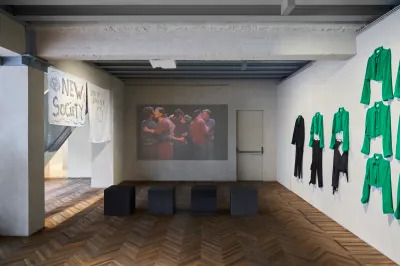
July: I remember looking at an early version of some of the videos and wondering if there were too many butts. What is the limit on butts? I actually talked about it with Mia Locks, the show’s curator, and in retrospect, I guess she must have gently headed me away from self-censorship because I did not think about it again, I just carried on. The shape is really nice, and when I realized I could isolate it and give the butt some agency it was pretty exciting and somehow less sexual in my mind. It became a kind of mushroom.
Sherman: A little peach.
July: Yes, a little peach moving around on its own. But now, as I get closer to finishing the videos, I am no longer alone with my thoughts and my process, and I am zooming out and trying to see these videos as other people might. And I think that technically that is my—is it called a split beaver shot?
Sherman: I don’t know.
July: It is a porn shot. Although I am wearing underwear and pantyhose.
Sherman: That is a nice touch. It is alluding to nudity but not really.
July: And the roughness of the cutout tool kept some things out of my control, which also confused my sense of authorship. Sometimes, when I was trying to present a butt, the tool spat out an empty hole instead, and there was nothing I could do about it, which was exciting and kind of moving to me.
You seem to use new technologies whenever they inspire you, without any fuss or fanfare, and I really like that. Can you tell me what that is like for you? Do you ever find a new tool that moves you?
Sherman: Learning how to use Photoshop has been inspiring to me. At first, it was daunting since almost anything is possible. I need limitations so that I have something to bounce my ideas against. And the apps that I have discovered for ‘traditional’ selfies have also been a big influence—of course, not using them the way they were intended. I am also enjoying certain aspects of AI.
July: Oh yes, I enjoy seeing those posts.
Sherman: Thanks. It has been fun. I do not feel threatened by AI. The AI images I put on Instagram are part of the ’playing around’ phase I do while building up to making the actual work, you know?
July: Yes, totally. That is how I feel about the dances I post. I am just playing around. It is not my work.
Sherman: And you kept that playful feeling all the way through to these videos.
July: I hope the yearning I felt when I was dancing alone comes through too. I often thought of yearning as one of my materials. Each new technology promises a new kind of intimacy that might somehow break through, make us feel not alone. Even email used to feel like that—sort of illicit. And then it becomes clear that this promise will not be fulfilled. So with F.A.M.I.L.Y., I am trying to manually, laboriously, fulfill what I see as one promise of Instagram: to bring other people into my space.
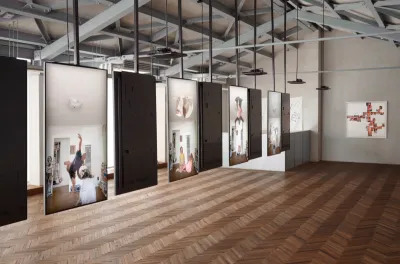
Sherman: It is interesting that you are using ‘longing’ or ‘yearning’ to connect as such a major part of the concept, that you are making work to not feel alone even though you are alone when you are doing the work. I work alone too, but I really love the solitude. How does it feel when you are making the work?
July: At times, the process can feel a bit reckless or risky even though it is completely consensual and safe. I made many images and videos over the course of the year with the research group, and there was a wild, highly sexualized moment early on where I had collaged images of the group members eating or sucking each other. I had actually forgotten how sexual it was at the start! I guess I had to pass through that phase in the process to get to the actual work, to something more personal. Do I really want to fuck strangers? No, but if I could be painlessly swallowed whole by another being . . .
Sherman: It sounds like you had meant to allude to sexuality almost from the beginning, that you had meant for it to be a merging of strangers’ bodies with yours?
July: Yes, that was always the idea. At first very bluntly, and eventually in a way that came out of a newly invented sexual language that is more spiritual to me. Or at least has a different relationship to gravity.
Sherman: Did you get to know the group pretty intimately?
July: Not as much as you would think, actually. I really only know them through their videos and the little exchanges we have had about logistics, where their personal lives would slip in. Someone might say, “Oh, I can’t shoot it this week. I’m taking care of my mom who fell.”
Sherman: Did everyone take it seriously, or did some people try to turn it into comedy? Did anyone ever get offended?
July: Somehow everyone was incredibly thoughtful and gracious all year, even while doing raunchy or strange things. I am so grateful and I always tried to express that and to show a lot of care. One member of the group said that because I upped the stakes so gingerly over such a long time, she felt like a frog in gradually boiling water: “You could ask us to do anything at this point.” [Laughs.]
Sherman: I could imagine a whole lot of them, even more videos . . .
July: Oh yes. I will add videos during the run of the show. The public will be invited to submit videos so I can pick new F.A.M.I.L.Y. members and keep adding to the group.
Sherman: Will you incorporate any people in Italy?
July: I hope so. There will be a link in my bio to Google Drive, where anyone can upload their own video. I hope this will help drive home the point that this is just a group of people who have never met in real life and others can join us remotely.
Sherman: And how are the videos going to be shown in the space? Are they projected?
July: Well, I have this model of the gallery here right next to me and I am figuring that out, but it is too early to say for sure.
Sherman: Do you have ideas for another film project?
July: Not really.
Sherman: It must be hard when your films have been so successful, and people, or your agent or whoever, must really pressure you to do more because you have got to make some more money.
July: I am not sure the films really make money. Or, in any case, all the agents understand what I am doing at this point—the multiplicity.
Sherman: I guess you approach it all as an artist, which is great. You are free to experiment.
July: That has always been the goal. What about you? I imagine there is a lot of pressure on you.
Sherman: I know that I am in a very fortunate position, and I do not feel like I have to prove anything. But there is definitely always the pressure of what will you do next. During COVID I could not focus on working at all, and then my gallery [Metro Pictures] was closing, and I had been with them since the beginning, for forty years.
July: Is that when you made the black-and-white work with the Photoshopped color parts? I love those. The wildly bloodshot eyes really got me, as someone whose eyes are often red.
Sherman: Yes, that work was done so last minute. I knew I was having a show in Zurich but I had no idea what I was going to produce. The show was opening in June and six months before, I told them [Hauser & Wirth] to come up with a plan B because I was not sure I would be able to make the work in time. But then once I said that, the pressure was gone, so I was able to just play around. Sometimes you have to do whatever feels good. One of the reasons I like working alone is that if something embarrasses me or if I hate something, no one has to know about it. I can just delete it. That is why I am still impressed by people who make films, because that one opportunity that I had [Office Killer (1997)] was so terrifying to me, working with a crew and everything.
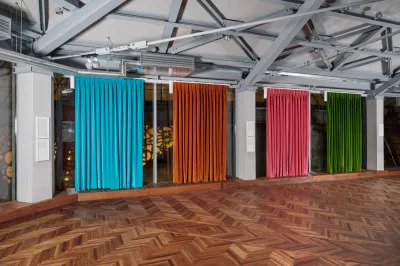
July: Making films is really hard. My process with these videos has been sort of the opposite of making a feature film. It is so private and unhinged.
Sherman: I think being playful, to experiment is the only thing you can do. You have to be open to anything because mistakes are half of what ends up being good in making art, the things that you were not expecting.
July: In play there is curiosity. What is going to happen? How is it going to turn out? What if I do this? I made some really horrible things that were so bad I had to laugh. When you are playing, the self-consciousness goes away. I am shutting off other knowledge. I am not thinking, which is such a relief. I don’t know if you find this, I am referring to when you are working, creating, and for once you have let go of all these other anxieties and the largeness of life . . . Is that how it is for you in the studio? A kind of hyperfocus?
Sherman: Yes, for me it is almost meditative, like I am in a zone, outside myself or on autopilot.
July: I relate to that. When I’m writing I see everything so clearly. Sometimes I only have to describe what I see, and when I make these videos it is similar. I am imagining the other person very clearly. To do the duet, I really need to think “I am going under their leg now.” I can see them in my head as I am moving and in just a second, after I import this video, I will get to see us together on the screen: there is a very satisfying joy in that. And in a way, all art is like that, because in the end you are going to get to show it to someone. You are hoping for a connection.
Sherman: But it is scary, too. I am thinking of the performance I saw you in, where you had the audience playing such important roles in the show.
July: You mean New Society (2015). I am showing documentation of that piece in the exhibition. Actually, the whole exhibition is called “New Society.”
Sherman: It seems like you thrive in scary situations, in risk-taking.
July: It is as though the risk is what allows me to do anything at all. If the stakes are not high, I will literally do nothing, just be a kind of humming brain in a state of paralysis. Ordinary tasks really overwhelm me. But something death-defying, seemingly impossible, will get me to put one foot in front of the other. Maybe I need something external that matches the intensity of my internal state. What is your internal state? Are you as calm as you seem?
Sherman: [Laughs.] I suppose I project a calm, mellow persona but I can be really hard on myself most of the time. I think that is one of the reasons I need to work alone. I do take more risks when I am alone, and risks are what makes the work interesting.
July: Yes, risk can feel almost devotional. Risking and letting go.
Sherman: Letting it fall apart.
Pino Pascali, a Little-Seen and Much-Loved Giant of Italian Art History, Gets a Retrospective in Milan
Failed Climate Protest at Musée d’Orsay, Cindy Sherman Joins ICP Board, and More: Morning Links for October 31, 2022

This $5.2 Million Lakeside Mansion Is Nestled in a Historic Resort Enclave Near Savannah
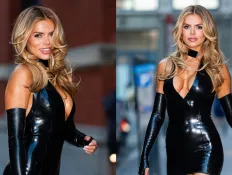
Brooks Nader Puts Sultry Spin on the Little Black Dress in Latex Look in New York

Another Netflix hit series returns with a 100% critics’ score

WNBA Business Turns the Corner—But Its Home Stretch Is Complicated
